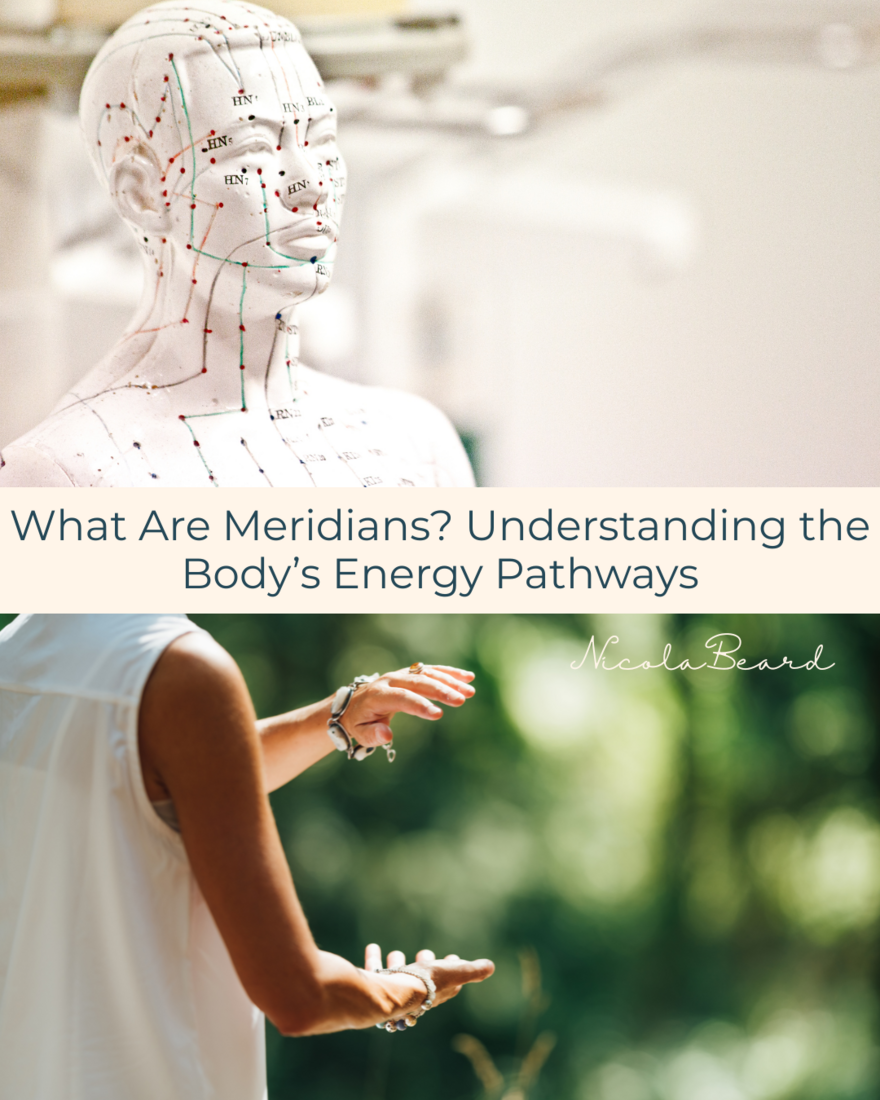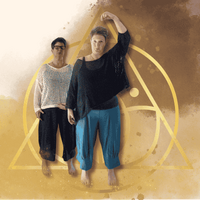
When you practise Tai Chi Qigong Shibashi, you are not simply moving your body for exercise. You are tuning into an energy system that links body, mind, and spirit. In Chinese tradition this energy is called qi (chee). Qi moves through pathways called meridians. These pathways shape how we feel, how we heal, and how we respond to stress. Once you understand meridians, the gentle flowing of Shibashi makes sense. It is not random, it is a carefully designed way of working with your body’s natural energy lines.
What Exactly Are Meridians?
Meridians are often called the body’s hidden map. They are not blood vessels or nerves, but channels of qi, the life energy that keeps us alive and well. The easiest way to imagine them is as rivers beneath the surface of the body. Some carry energy quickly, some store reserves, and others distribute nourishment steadily to keep everything working.
Just as a river system keeps land fertile, meridians keep the body in balance. When one river is blocked or running low, the whole system feels it. In your body this can show up as fatigue, stiffness, or unsettled emotions. When the rivers are flowing smoothly, energy is available where and when you need it. That is when you feel steady, resilient, and well.
Although meridians cannot be seen under a microscope, you have likely felt them in action. It might be the relief of tension easing with a stretch, the wave of calm after a deep breath, or the sense of lightness that comes after letting go of worry. These shifts are qi finding its way back into flow.
How Qi Flows Through the Body
Qi is always moving. Like tides or weather patterns, it changes in response to how we live, how we breathe, how we think, and even how we hold our posture.
When qi flows freely, you feel centred and clear. When it is blocked, life feels heavy, muddled, or unsettled. Stress, shallow breathing, long hours sitting, and unprocessed emotions all create blockages.
This same network of meridians is used in acupuncture and acupressure. Needles or gentle pressure are applied at points along these pathways to clear blockages and restore balance. In Shibashi we work with the same system, but instead of needles or touch we use flowing movement, posture, and breath to encourage qi to move freely.
Why Movement Helps the Meridians
Shibashi acts like irrigation for your inner landscape. Every movement is designed to spiral, stretch, or open a pathway. Wide arm sweeps expand the chest and free the lungs. Turning movements gently massage the liver and gallbladder. Shifting weight into the legs strengthens the kidneys, which are the body’s deep energy storehouse.
The key is not just movement, but movement linked with breath and awareness. That is what makes Shibashi more than exercise. Outer motion supports inner flow, and inner calm feeds back into the body. Body calms mind, mind frees body.
The Twelve Main Meridians at a Glance
Each of the twelve meridians has its own character. They connect physical functions, emotional states, and energetic qualities.
Lung – breath, immunity, ability to take in life
Large Intestine – digestion, letting go of what is no longer needed
Stomach – nourishment, grounded strength, worry
Spleen – circulation, energy reserves, overthinking
Heart – joy, clarity, vitality
Small Intestine – discernment, separating useful from waste
Bladder – elimination, flexibility, tension
Kidney – vitality, bones, courage in the face of fear
Pericardium – emotional safety, connection, intimacy
Triple Burner (San Jiao) – regulation, balance of fluids and warmth
Gallbladder – decisiveness, courage, adaptability
Liver – flow, vision, ability to plan and act
The Meridian Pairings
Each meridian has a partner. One is described as yin and the other as yang. In simple terms, yin relates to qualities of rest, storage, and nourishment, while yang relates to activity, movement, and expression. Yin gathers and protects, yang acts and delivers. Together, they make a complete system. If one partner is weak or blocked, the other struggles, and balance is lost.
Here is how the six pairs work:
Lung (yin) and Large Intestine (yang):
The lungs bring in fresh energy through breath. The large intestine clears waste. Together they represent the rhythm of taking in and letting go. When this pair is blocked, people may notice shallow breathing, low immunity, constipation, or difficulty releasing old emotions. Movements that open the chest and encourage deep breathing help restore balance here.Stomach (yang) and Spleen (yin):
The stomach receives and breaks down food. The spleen turns that nourishment into usable energy. They reflect how we process not only meals but also life experiences. When unsettled, this pair often shows up as worry, overthinking, or digestive discomfort. Gentle twisting movements, pressing the palms down, and grounding through the feet are especially helpful.Heart (yin) and Small Intestine (yang):
The heart governs circulation, warmth, and joy. The small intestine separates what is useful from what is not, both physically and emotionally. Together they support clarity of feeling and judgement. When blocked, it can feel like restlessness, anxiety, or difficulty connecting with joy. Flowing arm lifts and soft turns can calm and support this pair.Bladder (yang) and Kidney (yin):
The bladder clears water and waste. The kidneys store the body’s deepest reserves of vitality. Together, they give resilience and courage. When weak, this pair can lead to tiredness, stiffness in the back, or feelings of fear and insecurity. Movements that sink downward, flow to the feet, and gently stretch the back bring strength to this pair.Pericardium (yin) and Triple Burner (yang):
The pericardium acts as a protective shield around the heart, keeping it safe physically and emotionally. The triple burner regulates balance across the whole body, especially temperature and fluid circulation. Together, they help us set boundaries without shutting down connection. When out of balance, you may feel either closed off or emotionally overwhelmed. Circular arm movements and chest-opening exercises support this pair.Liver (yin) and Gallbladder (yang):
The liver ensures energy flows smoothly and supports planning and vision. The gallbladder provides decisiveness and courage to act. Together, they represent direction and movement. When blocked, this pair often creates frustration, irritability, indecision, or tension along the sides of the body. Turning, side stretches, and weight shifts in Shibashi help free this pair.
These pairings remind us that health is never about constant action or constant rest. It is about rhythm. Sometimes we need to pause, sometimes we need to move forward. Shibashi helps the body rediscover this rhythm, bringing the pairs back into harmony.
Everyday Benefits of Supporting Your Meridians
When meridians are flowing, you feel the difference in ordinary life:
Shoulders soften and breath deepens
Digestion feels steadier and energy less erratic
Emotions lose their sharp edges and moods smooth out
Sleep becomes more restful
Focus returns and thinking feels clearer
This shows up in small but important ways. Being calmer in a meeting. Walking up stairs with more ease. Handling a stressful day with steadiness instead of collapse.
Why Meridians Matter in Modern Life
Modern living constantly disrupts these pathways. Long hours sitting affect posture. Shallow breathing weakens lung energy. Rushing meals unsettles digestion. Stress sits like a knot in the body.
Shibashi offers a reset. It is a simple and gentle way to bring the system back into rhythm. You do not need to memorise the meridian map to benefit. You simply move, breathe, and notice. The shift speaks for itself. How do I feel before? How do I feel after?
The answer is usually lighter, calmer, more present. That is qi flowing as it should.
Conclusion
Meridians are the body’s hidden pathways of balance. Each time you practise Shibashi, you are clearing blockages, nourishing reserves, and restoring harmony between yin and yang.
This way of working with the body is not new. The roots of qigong stretch back more than 4,000 years, to some of the earliest breathing and movement practices recorded in China. Traditional Chinese Medicine, which describes the meridian system, has been studied and refined for at least 2,500 to 3,000 years. These traditions have lasted because they focus on the whole person, body, mind, and spirit in ways that are still relevant today.
Qigong and Traditional Chinese Medicine are not confined to the past. They are alive and thriving, used daily by hundreds of millions of people across the world. In homes, parks, and clinics, people of all ages are finding steadiness, health, and calm through these practices.
You do not need to believe in anything mystical or memorise the whole map of the body to benefit. What matters is the experience itself. The breath that comes easier, the body that feels lighter, the mind that finds stillness. When you practise Shibashi, you are stepping into a tradition that has supported human wellbeing for millennia, and you are joining a worldwide community who know the power of restoring balance through mindful movement.

Ready to feel it for yourself?
If you would like to experience how gentle movement can restore balance, start with my free Press Pause video. It is a short guided Shibashi practice you can use any time you need to reset and clear your mind.
